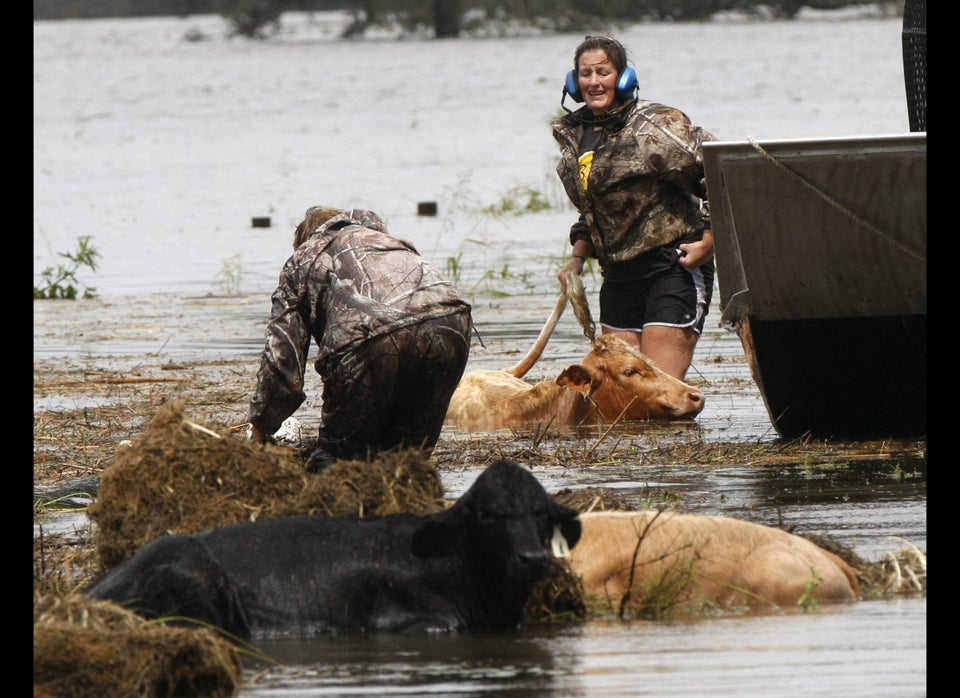* AIR, Eqecat says risks 'notable' but not huge
* CoreLogic estimated $36 bln in homes endangered
* Analysts say will not be material for insurers
By Ben Berkowitz and Myles Neligan
Aug 28 (Reuters) - Hurricane Isaac is likely to cause substantial flooding along the U.S. Gulf Coast, but losses should be a fraction of what they were when Hurricane Katrina plowed the same path in 2005, disaster experts said on Tuesday.
If anything, Isaac may draw closer parallels to last year's Hurricane Irene, which ended up primarily causing economic losses from inland flooding throughout the northeastern and New England states.
Some coastal areas could see up to 13 feet of storm surge from Isaac -- the water that a tropical cyclone pushes forward as it comes on land -- according to the latest National Hurricane Center estimates. Even well inland, as far north as Indiana by some projections, heavy rains are likely too.
By comparison, Katrina caused more than 25 feet of storm surge and more than $21 billion in surge losses, most of which were uninsured.
Not only is Isaac smaller, but coastal defenses are in many cases stronger than they were seven years ago, leaving damage experts much less concerned.
"Isaac is taking a similar track as Katrina but significantly lower winds ... a lot lower storm surge and wave heights," said Tom Larsen, senior vice president at disaster modeler Eqecat, in an interview. "The expected damage is very low because most of the storm attributes are within designs."
Even inland, where some farm states are expecting six inches of rain from Isaac's remnants, this summer's crushing drought means rivers and reservoirs are below normal, giving them greater capacity than usual to absorb floodwaters.
Larsen said it was far too early to hazard an estimate of actual damages, adding that it would be at least three hours after landfall before the firm could start to get a better loss picture. But he said that Isaac had the potential to at least be "notable" in the damage it causes.
AIR Worldwide, another of the major disaster modelers for the insurance industry, said the story of Isaac has been one of missed expectations.
"The potential is there for this to be a stronger storm, but ever since this thing was in the Caribbean it has not lived up to that potential at all," said Tim Doggett, the company's principal scientist.
Over the weekend, housing data specialist CoreLogic estimated that up to $36 billion in residential property along the coast could be at risk of flood damage from a Category 2 hurricane making landing in Louisiana or Mississippi. But that is a worst-case scenario, assuming all the properties in all the vulnerable areas were a total loss.
While insurers clearly expect substantial claims following Isaac, they appear to be relatively calm about the magnitude of losses, as do analysts following the sector.
"At this stage, I doubt whether it'll be a material event for the insurance and reinsurance industry," said Nick Johnson, insurance analyst at Numis Securities in London.
Along the Gulf Coast, the most exposed insurers include: State Farm, Allstate Corp and Southern Farm Bureau on the residential side; and Travelers, Zurich and CNA on the commercial side.
After last year's record-breaking losses from severe tornadoes, those insurers and their peers have had a much quieter 2012, which should also minimize the impact of any losses from Isaac.
"A category one (hurricane) bordering on a category two - if you live there it's not very nice - but it's really when you're talking about category three, four and five that you start thinking about material losses," said Joy Ferneyhough, insurance analyst at Espirito Santo bank in London.
Shares in major insurers were little moved in early-afternoon U.S. trade while the major European reinsurers were down slightly, as markets accepted that a repeat of Katrina was unlikely with Isaac.
"At this point I think those comparisons are inevitable, but I'm not sure how productive they are," AIR's Doggett said.
Our 2024 Coverage Needs You
It's Another Trump-Biden Showdown — And We Need Your Help
The Future Of Democracy Is At Stake
Our 2024 Coverage Needs You
Your Loyalty Means The World To Us
As Americans head to the polls in 2024, the very future of our country is at stake. At HuffPost, we believe that a free press is critical to creating well-informed voters. That's why our journalism is free for everyone, even though other newsrooms retreat behind expensive paywalls.
Our journalists will continue to cover the twists and turns during this historic presidential election. With your help, we'll bring you hard-hitting investigations, well-researched analysis and timely takes you can't find elsewhere. Reporting in this current political climate is a responsibility we do not take lightly, and we thank you for your support.
Contribute as little as $2 to keep our news free for all.
Can't afford to donate? Support HuffPost by creating a free account and log in while you read.
The 2024 election is heating up, and women's rights, health care, voting rights, and the very future of democracy are all at stake. Donald Trump will face Joe Biden in the most consequential vote of our time. And HuffPost will be there, covering every twist and turn. America's future hangs in the balance. Would you consider contributing to support our journalism and keep it free for all during this critical season?
HuffPost believes news should be accessible to everyone, regardless of their ability to pay for it. We rely on readers like you to help fund our work. Any contribution you can make — even as little as $2 — goes directly toward supporting the impactful journalism that we will continue to produce this year. Thank you for being part of our story.
Can't afford to donate? Support HuffPost by creating a free account and log in while you read.
It's official: Donald Trump will face Joe Biden this fall in the presidential election. As we face the most consequential presidential election of our time, HuffPost is committed to bringing you up-to-date, accurate news about the 2024 race. While other outlets have retreated behind paywalls, you can trust our news will stay free.
But we can't do it without your help. Reader funding is one of the key ways we support our newsroom. Would you consider making a donation to help fund our news during this critical time? Your contributions are vital to supporting a free press.
Contribute as little as $2 to keep our journalism free and accessible to all.
Can't afford to donate? Support HuffPost by creating a free account and log in while you read.
As Americans head to the polls in 2024, the very future of our country is at stake. At HuffPost, we believe that a free press is critical to creating well-informed voters. That's why our journalism is free for everyone, even though other newsrooms retreat behind expensive paywalls.
Our journalists will continue to cover the twists and turns during this historic presidential election. With your help, we'll bring you hard-hitting investigations, well-researched analysis and timely takes you can't find elsewhere. Reporting in this current political climate is a responsibility we do not take lightly, and we thank you for your support.
Contribute as little as $2 to keep our news free for all.
Can't afford to donate? Support HuffPost by creating a free account and log in while you read.
Dear HuffPost Reader
Thank you for your past contribution to HuffPost. We are sincerely grateful for readers like you who help us ensure that we can keep our journalism free for everyone.
The stakes are high this year, and our 2024 coverage could use continued support. Would you consider becoming a regular HuffPost contributor?
Dear HuffPost Reader
Thank you for your past contribution to HuffPost. We are sincerely grateful for readers like you who help us ensure that we can keep our journalism free for everyone.
The stakes are high this year, and our 2024 coverage could use continued support. If circumstances have changed since you last contributed, we hope you'll consider contributing to HuffPost once more.
Already contributed? Log in to hide these messages.


